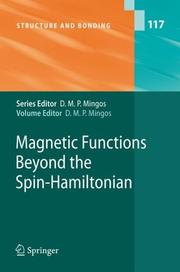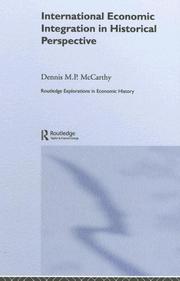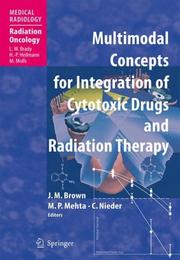| Listing 1 - 10 of 41 | << page >> |
Sort by
|

ISBN: 9783540260790 354026079X 3540325018 Year: 2006 Publisher: Berlin, Heidelberg : Springer Berlin Heidelberg : Imprint: Springer,
Abstract | Keywords | Export | Availability | Bookmark
 Loading...
Loading...Choose an application
- Reference Manager
- EndNote
- RefWorks (Direct export to RefWorks)
Using the spin-Hamiltonian formalism the magnetic parameters are introduced through the components of the Lambda-tensor involving only the matrix elements of the angular momentum operator. The energy levels for a variety of spins are generated and the modeling of the magnetization, the magnetic susceptibility and the heat capacity is done. Theoretical formulae necessary in performing the energy level calculations for a multi-term system are prepared with the help of the irreducible tensor operator approach. The goal of the programming lies in the fact that the entire relevant matrix elements (electron repulsion, crystal field, spin-orbit interaction, orbital-Zeeman, and spin-Zeeman operators) are evaluated in the basis set of free-atom terms. The modeling of the zero-field splitting is done at three levels of sophistication. The spin-Hamiltonian formalism offers simple formulae for the magnetic parameters by evaluating the matrix elements of the angular momentum operator in the basis set of the crystal-field terms. The magnetic functions for dn complexes are modeled for a wide range of the crystal-field strengths.
Magnetics. --- Nuclear spin. --- Hamiltonian systems. --- Spin nucléaire --- Systèmes hamiltoniens --- Chemistry. --- Chemistry, inorganic. --- Magnetism. --- Inorganic Chemistry. --- Theoretical and Computational Chemistry. --- Magnetism, Magnetic Materials. --- Magnetism --- Magnetic susceptibility --- Transition metal complexes --- Models, Molecular --- Molecular Structure --- Metals --- Magnetics --- Inorganic Chemicals --- Physics --- Models, Theoretical --- Biochemical Phenomena --- Physicochemical Phenomena --- Chemical Phenomena --- Natural Science Disciplines --- Investigative Techniques --- Phenomena and Processes --- Chemicals and Drugs --- Analytical, Diagnostic and Therapeutic Techniques and Equipment --- Disciplines and Occupations --- Physical & Theoretical Chemistry --- Inorganic Chemistry --- Chemistry --- Physical Sciences & Mathematics --- Magnetic susceptibility. --- Transition metal complexes. --- Investigative Technics --- Investigative Technic --- Investigative Technique --- Technic, Investigative --- Technics, Investigative --- Technique, Investigative --- Techniques, Investigative --- Natural Sciences --- Physical Sciences --- Discipline, Natural Science --- Disciplines, Natural Science --- Natural Science --- Natural Science Discipline --- Physical Science --- Science, Natural --- Science, Physical --- Sciences, Natural --- Sciences, Physical --- Chemical Phenomenon --- Chemical Process --- Physical Chemistry Phenomena --- Physical Chemistry Process --- Physicochemical Phenomenon --- Physicochemical Process --- Chemical Concepts --- Chemical Processes --- Physical Chemistry Concepts --- Physical Chemistry Processes --- Physicochemical Concepts --- Physicochemical Processes --- Chemical Concept --- Chemistry Process, Physical --- Chemistry Processes, Physical --- Concept, Chemical --- Concept, Physical Chemistry --- Concept, Physicochemical --- Concepts, Chemical --- Concepts, Physical Chemistry --- Concepts, Physicochemical --- Phenomena, Chemical --- Phenomena, Physical Chemistry --- Phenomena, Physicochemical --- Phenomenon, Chemical --- Phenomenon, Physicochemical --- Physical Chemistry Concept --- Physicochemical Concept --- Process, Chemical --- Process, Physical Chemistry --- Process, Physicochemical --- Processes, Chemical --- Processes, Physical Chemistry --- Processes, Physicochemical --- Biochemical Concepts --- Biochemical Phenomenon --- Biochemical Process --- Phenomena, Biochemical --- Biochemical Processes --- Biochemical Concept --- Concept, Biochemical --- Concepts, Biochemical --- Phenomenon, Biochemical --- Process, Biochemical --- Processes, Biochemical --- Experimental Model --- Experimental Models --- Mathematical Model --- Model, Experimental --- Models (Theoretical) --- Models, Experimental --- Models, Theoretic --- Theoretical Study --- Mathematical Models --- Model (Theoretical) --- Model, Mathematical --- Model, Theoretical --- Models, Mathematical --- Studies, Theoretical --- Study, Theoretical --- Theoretical Model --- Theoretical Models --- Theoretical Studies --- Physic --- Chemicals, Inorganic --- Magnetic --- Structure, Molecular --- Molecular Structures --- Structures, Molecular --- Molecular Models --- Model, Molecular --- Molecular Model --- Susceptibility, Magnetic --- Inorganic chemistry --- Inorganic chemistry. --- Chemistry, Physical and theoretical. --- Magnetic materials. --- Inorganic compounds --- Mathematical physics --- Electricity --- Physical sciences --- Chemistry, Theoretical --- Physical chemistry --- Theoretical chemistry --- Materials
Digital
ISBN: 9783540325017 Year: 2006 Publisher: Berlin Heidelberg Springer-Verlag GmbH
Abstract | Keywords | Export | Availability | Bookmark
 Loading...
Loading...Choose an application
- Reference Manager
- EndNote
- RefWorks (Direct export to RefWorks)
Electromagnetism. Ferromagnetism --- Inorganic chemistry --- Chemistry --- Computer. Automation --- chemie --- informatica --- anorganische chemie --- magnetisme
Book
Year: 2006 Publisher: Waterloo Kluwer
Abstract | Keywords | Export | Availability | Bookmark
 Loading...
Loading...Choose an application
- Reference Manager
- EndNote
- RefWorks (Direct export to RefWorks)

ISBN: 0415770270 9780415770279 Year: 2006 Publisher: Abington Routledge
Abstract | Keywords | Export | Availability | Bookmark
 Loading...
Loading...Choose an application
- Reference Manager
- EndNote
- RefWorks (Direct export to RefWorks)
International economic integration --- International economic relations --- History
Book
ISBN: 9789250054483 9250054483 Year: 2006 Publisher: Rome: FAO,
Abstract | Keywords | Export | Availability | Bookmark
 Loading...
Loading...Choose an application
- Reference Manager
- EndNote
- RefWorks (Direct export to RefWorks)
Book
ISBN: 9783540325017 Year: 2006 Publisher: Berlin Heidelberg Springer-Verlag GmbH.
Abstract | Keywords | Export | Availability | Bookmark
 Loading...
Loading...Choose an application
- Reference Manager
- EndNote
- RefWorks (Direct export to RefWorks)
Using the spin-Hamiltonian formalism the magnetic parameters are introduced through the components of the Lambda-tensor involving only the matrix elements of the angular momentum operator. The energy levels for a variety of spins are generated and the modeling of the magnetization, the magnetic susceptibility and the heat capacity is done. Theoretical formulae necessary in performing the energy level calculations for a multi-term system are prepared with the help of the irreducible tensor operator approach. The goal of the programming lies in the fact that the entire relevant matrix elements (electron repulsion, crystal field, spin-orbit interaction, orbital-Zeeman, and spin-Zeeman operators) are evaluated in the basis set of free-atom terms. The modeling of the zero-field splitting is done at three levels of sophistication. The spin-Hamiltonian formalism offers simple formulae for the magnetic parameters by evaluating the matrix elements of the angular momentum operator in the basis set of the crystal-field terms. The magnetic functions for dn complexes are modeled for a wide range of the crystal-field strengths.
Electromagnetism. Ferromagnetism --- Inorganic chemistry --- Chemistry --- Computer. Automation --- chemie --- informatica --- anorganische chemie --- magnetisme
Book
Year: 2006 Publisher: Amsterdam Uitgeverij Bert Bakker
Abstract | Keywords | Export | Availability | Bookmark
 Loading...
Loading...Choose an application
- Reference Manager
- EndNote
- RefWorks (Direct export to RefWorks)
Book
Year: 2006 Publisher: Bruxelles Scientific Institut of Public Health Louis Pasteur. Division Toxicology
Abstract | Keywords | Export | Availability | Bookmark
 Loading...
Loading...Choose an application
- Reference Manager
- EndNote
- RefWorks (Direct export to RefWorks)
Book
Year: 2006 Publisher: [Place of publication not identified] Springer
Abstract | Keywords | Export | Availability | Bookmark
 Loading...
Loading...Choose an application
- Reference Manager
- EndNote
- RefWorks (Direct export to RefWorks)
Nuclear Magnetic Resonance (NMR) is based on the fact that certain nuclei exhibit a magnetic moment, orient by a magnetic field, and absorb characteristic frequencies in the radiofrequency part of the spectrum. The spectral lines of the nuclei are highly influenced by the chemical environment i.e. the structure and interaction of the molecules. NMR is now the leading technique and a powerful tool for the investigation of the structure and interaction of molecules. The present Landolt-Börnstein volume III/35 "Nuclear Magnetic Resonance (NMR) Data" is therefore of major interest to all scientists and engineers who intend to use NMR to study the structure and the binding of molecules. Volume III/35 "NMR-Data" is divided into several subvolumes and parts. Subvolume III/35A contains the nuclei 11B and 31P, subvolume III/35B contains the nuclei 19F and 15N, subvolume III/35C contains the nucleus 1H, subvolume III/35D contains the nucleus 13C, and subvolume III/35E contains the nucleus 17O. More nuclei will be presented later.

ISBN: 1280617616 9786610617616 3540356622 3540256555 3642065058 Year: 2006 Publisher: Berlin ; New York : Springer,
Abstract | Keywords | Export | Availability | Bookmark
 Loading...
Loading...Choose an application
- Reference Manager
- EndNote
- RefWorks (Direct export to RefWorks)
Over recent decades, combined modality treatment has drastically improved the cure rates for various malignant tumors. Further progress is expected through the design of sound combinations involving recently developed drugs. The first part of this book summarizes the rationale and the preclinical data for combined treatment with ionizing radiation and pharmaceutical agents. Individual chapters focus on different forms of combined treatment, with due consideration being given to a range of drugs and to emerging combinations with small molecules and antibodies, derived from recent advances in molecular oncology. The second part of the book comprises a series of disease-specific chapters in which the clinical results of combined modality treatment are presented. In addition, the topics of acute and late toxicity, supportive treatment and tolerance in elderly patients are reviewed. All of the chapters have been written by basic scientists and clinicians who are acknowledged experts in the field. The text is specifically designed to be accessible to professionals from the various disciplines involved in multidisciplinary cancer care and to residents in radiation oncology training programs.
Cancer --- Radiotherapy. --- Treatment. --- Cancer therapy --- Cancer treatment --- Therapy --- Treatment --- Radiology, Medical. --- Oncology . --- Biochemistry. --- Surgery. --- Pneumology. --- Imaging / Radiology. --- Oncology. --- Medical Biochemistry. --- Pneumology/Respiratory System. --- Surgery, Primitive --- Medicine --- Biological chemistry --- Chemical composition of organisms --- Organisms --- Physiological chemistry --- Biology --- Chemistry --- Medical sciences --- Tumors --- Radiation therapy --- Electrotherapeutics --- Hospitals --- Medical electronics --- Medical radiology --- Therapeutics, Physiological --- Phototherapy --- Clinical radiology --- Radiology, Medical --- Radiology (Medicine) --- Medical physics --- Composition --- Radiological services --- Radiology. --- Medical biochemistry. --- Respiratory organs—Diseases. --- Medical biochemistry --- Pathobiochemistry --- Pathological biochemistry --- Biochemistry --- Pathology --- Radiological physics --- Physics --- Radiation
| Listing 1 - 10 of 41 | << page >> |
Sort by
|

 Search
Search Feedback
Feedback About UniCat
About UniCat  Help
Help News
News